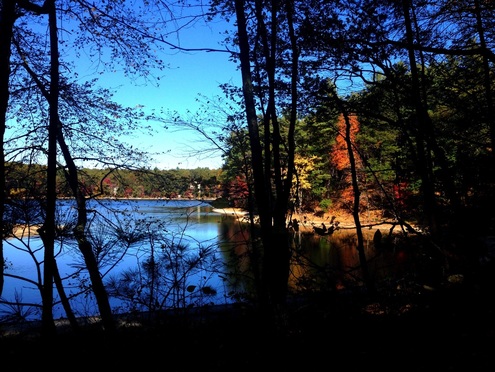This is a crucial time in the life of White Pond, its natural environment and the surrounding neighborhoods. The Pond experienced the most serious toxic algae bloom on record this past summer leading to a swimming ban. Today five major problems are converging to threaten the well-being of the White Pond ecosystem:
1. Global warming has come to White Pond. Like other local ecosystems, White Pond is already experiencing warmer seasonal temperatures that affect the Pond's vegetation and wildlife. Higher water temperatures combined with the nutrients (phosphorous) in storm water run-off from the access road and the erosion sites around the pond, feed the algae which then bloom and release toxins. Global warming also means more droughts which lower the level of water in the pond. Less volume of water combined with higher temperatures means could lead to more frequent toxic algae outbreaks.
Global warming also brings eco-stress and more swimmers. 2015 was the hottest year on record. Global warming means more hot days during the year resulting in more people looking for a place to swim. According to the EPA, the Boston area is projected to experience an increase in the number of days reaching 100°F rising dramatically from a past average of 1 day per year to 24 days per year by 2100.
The primary access to Sachem's Cove is through private streets and conservation land. The Select Board has voted to prohibit swimming during the restoration of the shoreline on town owned land and hired rangers to enforce this ban. Unauthorized swimming causes increased traffic, speeding, parking and safety issues in the surrounding neighborhoods. The net result is a degradation of ecosystem including erosion and water quality issues.
2. Lack of coordination of property owners. The many property owners of White Pond operate independently without any oversight. The EPA recommends the best way to manage lakes and ponds is a lake association. The major stakeholders of the pond include: State of Massachusetts (owner of the pond up to the shoreline), Town of Concord (largest landowner on the pond), White Pond Associates (owner of the Plainfield Rd beach and adjacent fields), Thoreau club, neighborhood beach associations, private homeowners in the watershed, and adjacent neighborhoods (including Stone Root Lane and the Town of Sudbury Frost Farm neighborhood). Town agencies who have an interest in the health of the pond include the Board of Health, the Water Department who maintains the town well located 1,000 feet from Sachem's Cove and the Department of Natural Resources who manages the conservation land.
The White Pond Advisory Committee is a five-member committee appointed by the Select Board to review and analyze the concerns of the White Pond neighborhood. This committee could explore the possibility of a watershed association and sponsor an annual roundtable discussion of all interested stakeholders. This meeting could be based on the recent WPAC vision statement and the ESS report and begin the process of a coordinated effort to preserve the pond.
3. Erosion from storm run-off. Storm run-off from the many erosion sites around the pond feed the algae with nutrients contained in the run-off. The algae which normally exists in water then blooms and releases toxins which can cause health problems for people and dogs.
4.. The Internet Age brings increased visibility and more swimmers. Because of nearby Walden Pond State Park, Concord has long been a destination for out-of-town swimmers. The Internet put an end to White Pond's "cloak of invisibility." Now blogs and "Best Places to Swim" websites direct people to the free swimming available at White Pond. People tweet their friends to join them at the idyllic swimming hole they just discovered. Alcohol frequently accompanies these visitors. They leave behind bottles, cans, take-out containers and other litter and at times make campfires and destroy the posted signs and ropes installed by the town. They use the pond and the nearby woods as a toilet since there are no restrooms. Now GPS reveals the previously hidden Pond to passers-by, making it easy to drive or bike to the Pond. Up until the Select Board vote to close Sachem's Cove to swimming this past summer, for many out-of-town swimmers it was an attractive alternative to the crowded, regulated, fee-based swimming at Walden Pond. When Walden's parking lot was full, dozens of hot, frustrated swimmers found their way to White Pond with its unlimited free parking in nearby neighborhoods.
5.The Rail Trail will soon bring increased visibility and more swimmers. In 2-3 years the Concord section of Bruce Freeman Rail Trail (BFRT) will be built, exposing the Pond to many more swimmers. From the perspective of the Pond, the BFRT is like an asphalt bicycle highway bringing as many as 1,000 additional visitors a day into her already fragile ecosystem (based on BFRT estimates cited in ESS White Pond Watershed Management Plan, p. 47).

 RSS Feed
RSS Feed